
Thimbleweed Park Review
Every so often, a game comes around which redefines a genre. Adventure games had been around for a while before Maniac Mansion was released in 1987; most were text based affairs that perhaps had some static pictures. At the same time there were also already animated adventures like Dizzy and Finders Keepers. Ron Gilbert and Gary Winnick’s debut with LucasFilm Games (later LucasArts) was the first to fuse that “verb and noun” style of text adventure with the smooth animated nature of those early adventure titles; throw in their unique self-aware and quirky sense of humour and suddenly the point and click adventure was born.
Gilbert and Winnick went on to create a raft of classics, including The Curse of Monkey Island, a personal favourite of mine. 30 years after that first title, the duo have reunited to create Thimbleweed Park, a new game in the style of those classic LucasArts adventures both in terms of artwork and feel. The game was funded through Kickstarter, and with over 15,000 backers invested in the game, along with the weight of creating some of the best games in the genre, there’s a lot of expectation riding on it.
At this point, I should probably draw attention to the clickable author name at the top of this article, which will give you some details about me and a picture of my face. I do this largely for the benefit of my friends and family, who haven’t seen it in the last week; the reason is Thimbleweed Park. This should give you an idea as to how well the game lived up to those aforementioned expectations. I have left my computer this week, but mainly that was to eat, drink and sleep. Honestly, I haven’t got this hooked to an adventure game since Monkey Island.
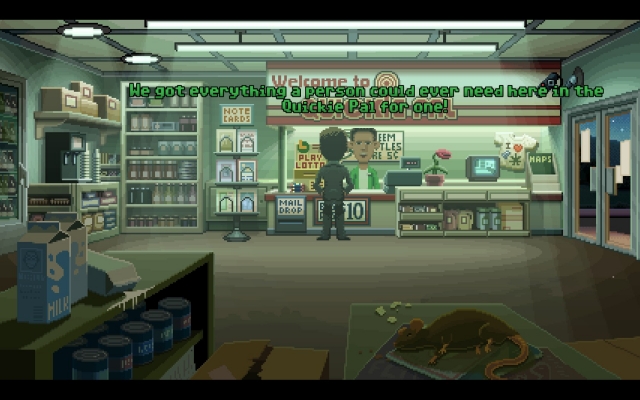
One of the things that made the aforementioned classic title so compelling for me was the scripting. Gilbert is a master at creating quirky characters and an expert at the use of self-referential humour, and fourth-wall-breaking. This is evidenced highly in Thimbleweed Park, with an esoteric cast of eccentric characters throughout, both playable and non-playable.
You’ll switch between characters throughout the game, and just like in Maniac Mansion, you’ll need to utilise multiple characters to solve puzzles. This could be as simple as passing items between characters, or two things have to be done simultaneously so you’ll need both characters in the same place at the same time. In addition to this, some tasks can only be done by certain characters, this is an inspired mechanic as it means that you will spend a good amount of time playing as each of the main characters, which in turn gives you a sense of a story developing organically like in a book or movie. You really get a sense of depth, with multiple viewpoints and different characters having different stories that all stem from the central murder mystery plot.
It looks exactly like a game from the 1980s but with a little more polish added to match up with modern standards. You can change the font to a cleaner, non-pixelated one and you can move the position of the text to follow the cursor. Neither of these looked quite right to me so I left them switched off, but it’s nice to know they are there. There’s also the option to change from the verbs being block letters or a little more fancy, which I did take advantage of. It’s a perfect compromise between authenticity and modern game design.
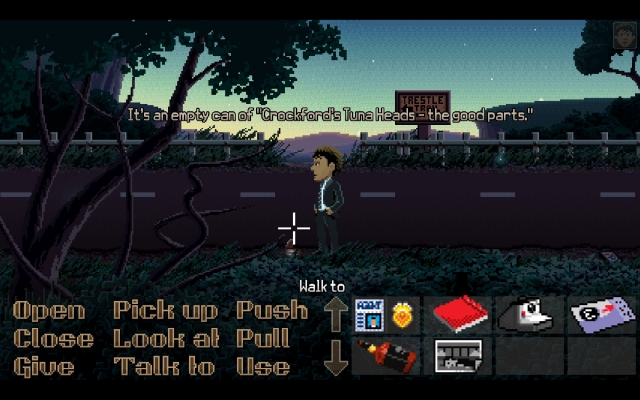
Another compromise to modernisation is the option of a difficulty level. You can play the game in an easy mode with fewer puzzles and some easier solutions. I played it in the regular hard mode and it gets the balance just right, as you’d expect from the man who perfected adventure game design. There’s plenty of red herring objects and clues scattered about, and although some of the puzzles require a little warming up of the old grey matter, none of them are too obtuse. One of my pet hates in this type of game is puzzles that see you just rubbing everything in your inventory together and hoping for the best. Everything makes logical sense, but nothing is so easy as to deprive you of that sense of satisfaction when you finally crack it.
There’s a lovely soundtrack running throughout. Although it seems stylistically correct for the era aped by this game, it is noticeably higher quality than you would have seen back in the day. It uses real instruments for heaven’s sake! Bits of it reminded me of the old alt rock bands like The Eagles or Pink Floyd. It might not be as iconic as Monkey Island or the like, but it serves a purpose, and let’s be honest, you’re not playing a point and click adventure for the soundtrack are you?
What I thought was particularly astute here was the game keeping the spirit of those old classics without being an actual sequel. If you’ve never played Monkey Island or Maniac Mansion you won’t be hindered. This is a new setting, with new characters, and you don’t need to have played the previous games. This means it’s far more accessible, and you’re experiencing a new story for the first time, rather than seeing old ground re-trodden.
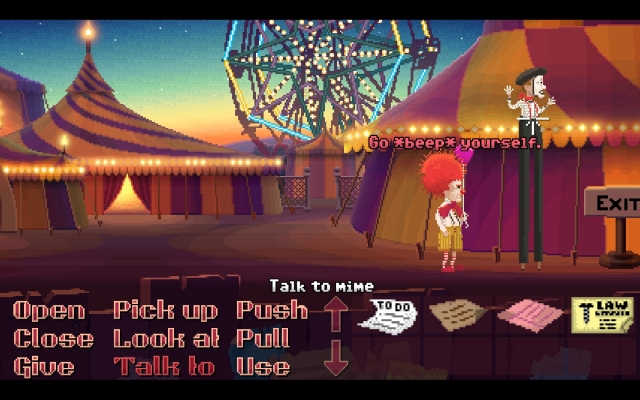
That’s not to say that there’s no benefit to having played some of Gilbert’s back catalogue. This is a game that knows exactly who its primary fans are going to be, and it does as much as it can do to appease them. There’s a bunch of references to previous titles. Like the mansion one character lives in with a clock that looks “strangely familiar” or the inclusion of Edna in the in-game phone system.
As a Kickstarter funded game, you expect to see some homages to those that created it, and these things are all over the place. This was something that I thought was a brilliant touch. Instead of just sticking the names of all the backers in the credits, the game makes them part of it. There’s a library in the game, with hundreds of books included, all written by backers. That phone system I mentioned earlier? That’s full of backers too, with users having been able to record their own voicemail message to be used in the game and their name forever immortalised in the game’s telephone directory.
It’s little touches like the above that set Thimbleweed Park above its competition. There are lots of little extras that aren’t strictly necessary, but still enhance the game. There are entire puzzles that you don’t have to complete to move the story along; they’re just fun to do. With a load of collectible items and quirky achievements, there’s a lot to do as well as just finding out who put a hole in the head of the corpse you meet in the first part of the game.
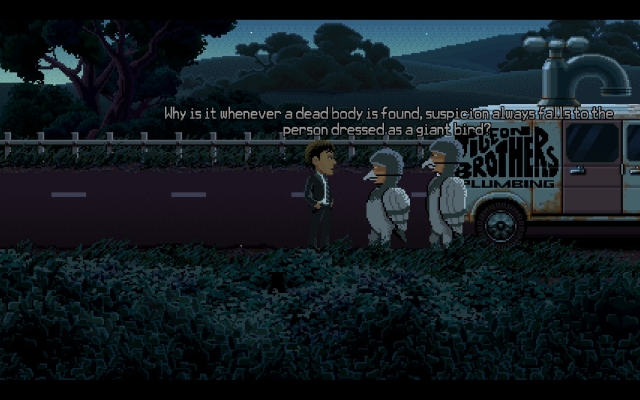
When reviewing games, I always try to get a good few hours of play in so as to be able to review it fairly. Due to time constraints, I don’t always finish a title however. This game was definitely an exception to that pattern, and I just couldn’t tear myself away until I’d finished the whole thing and watched the ending (which was superb by the way).
In a nutshell, Thimbleweed Park is by far and away one of the best adventure games that I’ve played in years and it’s a fine return to form from the master of the genre. I loved every minute of it and I’ll no doubt go back and try and get the last few achievements that I missed after this review is done and dusted. If you like adventure games, then you absolutely must get yourself a copy of this game.
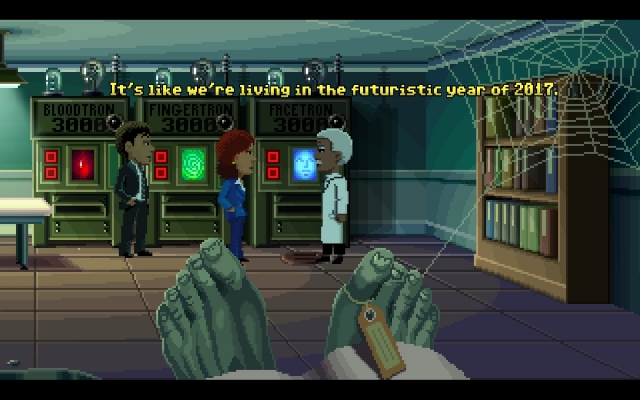
Thimbleweed Park (Reviewed on Windows)
Outstanding. Why do you not have this game already?
Another masterpiece from Ron Gilbert. The game is a joy to play and provides the perfect mix of humour, challenge and engaging storyline. I genuinely have nothing but praise for the game and I can’t recommend it enough.




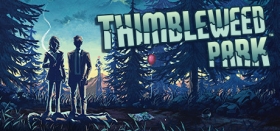






COMMENTS